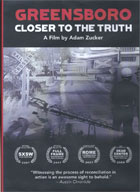
Greensboro: Closer to the Truth 2007
Distributed by Filmakers Library, 124 East 40th Street, New York, NY 10016; 202-808-4980
Produced by Adam Zucker
Directed by Adam Zucker
DVD, color, 83 min.
Sr. High - Adult
African American Studies, Human Rights, Labor Relations
Date Entered: 07/15/2009
Reviewed by Timothy W. Kneeland, History and Political Science Department, Nazareth College of Rochester, Rochester, NYAdam Zucker has created a first rate documentary that brings to light a little known incident in recent US history, the violent murder of five members of the Communist Workers Party by members of the KKK and American Nazi Party on November 3, 1979. The focal point of the documentary is how this event, which local authorities largely ignored and for which members of the hate groups were not prosecuted, festered among survivors of the attack for nearly a quarter of a century until they were moved to create the first Truth and Reconciliation Commission in U.S. history.
In the 1970s a group of black and white organizers from both North Carolina and New York City converged in Greensboro, North Carolina to unionize the textile mills, ultimately forming the Communist Workers Party (CWP). They encountered resistance from the local KKK. In the late summer of 1979 Klan members announced they would have a free public showing of Birth of a Nation as part of a recruitment drive. Hearing of this, members of the CWP organized a protest and arrived at the event with banners and chants of “Death to the Klan.” Although the resulting confrontation was tense no violence occurred at this time. However, on November 3, 1979 the CWP called for an anti-Klan rally and publicized this event with their slogan “Death to the Klan.” In protest members of the KKK showed up and the ensuing confrontation led to the tragic death of five members of the CWP after well-armed Klan members shot at the demonstrators. Four organizers were killed outright and within days a fifth member died. Police, who remained conspicuously absent during the violent clash, showed up but only arrested one of the local CWP organizers for inciting riot. Klan members were not charged with murder. Eventually, the city of Greensboro quietly paid off the surviving members of the CWP and families of the victims but never admitted any wrongdoing. Frustrated by a quarter century of silence, the victims and family members of those slain, sought a means to redress their grievance by forming a Truth and Reconciliation Commission.
The commission, lacking the support of local or state political leaders and not widely embraced by the broader community, was unable to cultivate real reconciliation. Viewers will have to determine for themselves whether the outcome, which seemed predetermined, ever gained the truth. However, the documentary shows how those who felt wronged gained a sense of peace when their beliefs were validated by an outside agency.
The film is well shot. The scenes are vivid and the interviews cover a wide variety of civic leaders, activists, and local citizenry. Two characters in particular engage the viewer. One is the Reverend Nelson Johnson. Johnson was a militant leader of the Communist Workers Party who turned his life over to God and became a minister in 1986. Perhaps because of his religious convictions, Johnson seems to be authentically interested in the truth and reconciling with those who attacked him. He acknowledges that his actions in 1979, such as calling for “Death to the Klan” may have been construed by the hate group as a call to kill Klansmen and provoked to some extent the confrontation that led to the death of five of his friends. The other character is Joseph Gorrell Pierce, a former member of the American Nazi Party, who reflects on how his own actions were motivated by hatred and bigotry. He too seems to have begun the path to finding his way out of old hatreds.
The film would be useful for students of peace and justice, and for understanding the lingering racism that still haunts American cities.